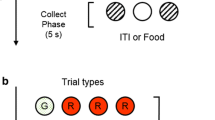Abstract
In Experiment 1 each rat received two different fixed series of three trials each. The unconditioned stimulus occurred on Trial 1 of one series and on Trial 3 of the other series, all other trials being nonreinforced. Previous Pavlovian investigations have shown that rats can remember the immediately prior reward outcome and anticipate the immediately subsequent reward outcome. Experiment 1 demonstrated that rats could remember and anticipate even more remote reward outcomes. In Experiment 2 two groups received a series of two nonrewarded trials followed by a rewarded trial. It was demonstrated that a change in the conditioned stimulus (CS) from Trial 2 to Trial 3, which occurred in one group, produced weaker responding than in the other group that did not experience such CS change. On the basis of these findings it was suggested that the rats organized the trials of a series into a unit or chunk. This was concluded for two reasons. First, remembering and anticipating remote reward outcomes strongly suggests that responding is being controlled by events extending beyond the current trial. Secondly, the experimental manipulations employed in the Pavlovian situation here are similar to those used in prior human learning and animal instrumental learning investigations concerned with chunking. Thus, it would appear that chunking is a ubiquitous phenomenon appearing in human serial learning (e.g., Bower and Winzenz 1969; Crowder 1976), in animal instrumental learning (e.g., Capaldi 1992; Hulse and Dorsky 1977; Terrace 1987), and now in Pavlovian learning.


Similar content being viewed by others
References
Bouton ME (2002) Context, ambiguity, and unlearning: sources of relapse after behavioral extinction. Biol Psychiatry 52:976–989
Bouton ME, Woods AW, Pineño O (2004) Occasional reinforced trials during extinction can slow the rate of rapid reacquisition. Learn Motiv 35:371–390
Bower GH, Winzenz D (1969) Group structure, coding, and memory for digit series. J Exp Psychol Monogr 80(Part 2):1–17
Capaldi EJ (1967) A sequential hypothesis of instrumental learning. In: Spence KW, Spence JT (eds) The psychology of learning and motivation, vol 1. Academic, New York, pp 67–156
Capaldi EJ (1992) Levels of organized behavior in rats. In: Honig WK, Fetterman JG (eds) Cognitive aspects of stimulus control. Erlbaum, Hillsdale, pp 385–404
Capaldi EJ (1994) The sequential view: from rapidly fading stimulus traces to the organization of memory and the abstract concept of number. Psychon Bull Rev 1:156–181
Capaldi EJ, Berg R, Morris MD (1975) Stimulus control of responding in the early trials of differential conditioning. Learn Motiv 6:217–229
Capaldi EJ, Haas A, Miller RM, Martins A (2005) How transitions from nonrewarded to rewarded trials regulate responding in Pavlovian and instrumental learning following extensive acquisition training. Learn Motiv 36:279–296
Capaldi EJ, Martins A, Miller RM (2007) Cues produced by reward and nonreward and temporal cues influence responding in the intertrial interval and to the conditioned stimulus. Learn Motiv 38:1–15
Crowder RC (1976) Principles of learning and memory. Erlbaum, Hillsdale
Gallistel R, Gibbon J (2000) Time, rate, and conditioning. Psychol Rev 107:289–344
Haselgrove M, Aydin A, Pearce JM (2004) A partial reinforcement extinction effect despite equal rates of reinforcement during Pavlovian conditioning. J Exp Psychol Anim Behav Process 30:240–250
Hulse SH, Dorsky NP (1977) Structural complexity as a determinant of serial pattern learning. Learn Motiv 8:488–506
Miller RM, Capaldi EJ (2006) An analysis of sequential variables in Pavlovian conditioning. Learn Motiv 37:289–392
Mowrer RR, Klein SB (2001) Handbook of contemporary learning theories. Erlbaum, Mahwah
Pearce JM, Hall G (1980) A model for Pavlovian learning: variations in the effectiveness of conditioned but not unconditioned stimuli. Psychol Rev 87:532–552
Poulos CX, Sheafor PJ, Gormezano I (1971) Classical appetitive conditioning of the rabbit’s (Oryctolagus cuniculus) jaw-movement response with a single-alternation schedule. J Comp Physiol Psych 75:231–238
Rescorla RA, Wagner AR (1972) A theory of Pavlovian conditioning: variations in the effectiveness of reinforcement and nonreinforcement. In: Black AH, Prokasy WF (eds) Classical conditioning II: current research and theory. Appleton-Century-Crofts, New York, pp 64–99
Terrace HS (1987) Chunking by a pigeon in a serial learning task. Nature 325:149–151
Wagner AR (1978) Expectancies and the priming of STM. In: Hulse SH, Fowler H, Honig WK (eds) Cognitive processes in animal behavior. Erlbaum, Hillsdale pp 177–209
Acknowledgments
The experiments reported here do not violate any laws of the United States of America.
Author information
Authors and Affiliations
Corresponding author
Rights and permissions
About this article
Cite this article
Martins, A.P.G., Miller, R.M. & Capaldi, E.J. Memories and anticipations control responding by rats (Rattus norvegicus) in a Pavlovian procedure. Anim Cogn 11, 59–66 (2008). https://doi.org/10.1007/s10071-007-0084-5
Received:
Revised:
Accepted:
Published:
Issue Date:
DOI: https://doi.org/10.1007/s10071-007-0084-5




